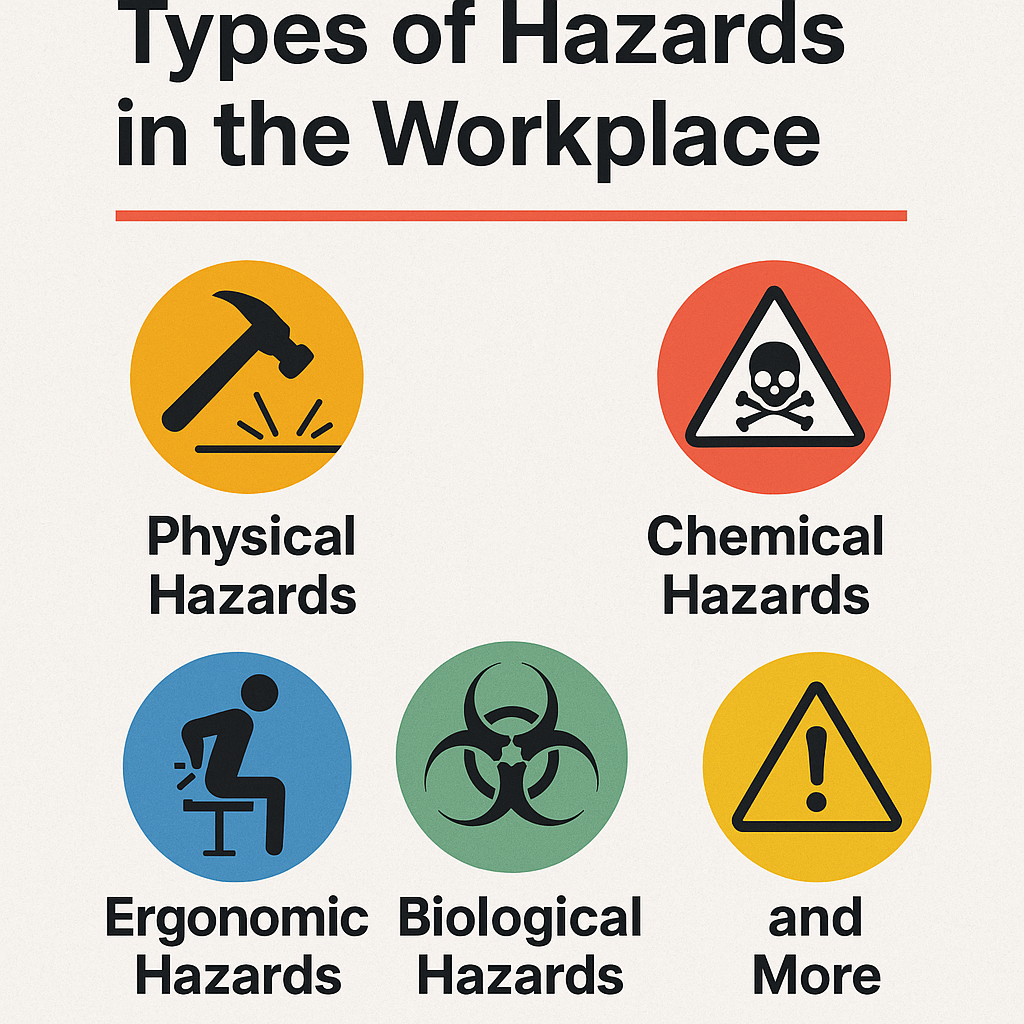
Types of Hazards in the Workplace: Physical, Chemical, Biological, Ergonomic, and More
Imagine walking into your job every day without knowing there’s a hidden danger right under your nose. Scary, right? Workplace hazards are everywhere—from loud machines to invisible viruses. If left unchecked, they can lead to injury, illness, or worse. That’s why understanding the types of workplace hazards is crucial to keeping yourself and your team safe.
What Is a Workplace Hazard?
A hazard is anything that can cause harm—physically, mentally, or emotionally. It can be a substance, object, situation, or behavior. On the other hand, risk is the likelihood of that hazard actually causing harm. Simple, right?
For example: A slippery floor is a hazard. The risk is someone slipping and getting injured.
Major Categories of Workplace Hazards
Let’s break down the major types of workplace hazards one by one. Each category poses a unique threat—and understanding them is the first step to controlling them.
Physical Hazards
These are the most visible hazards in the workplace. Think of anything that can physically hurt you.
Examples Include:
- Unguarded machinery
- Noise
- Radiation
- Vibration
- Extreme temperatures
- Poor lighting
Common Industries Affected:
- Construction
- Manufacturing
- Mining
- Warehousing
Preventive Measures:
- Use personal protective equipment (PPE)
- Install machine guards
- Ensure proper ventilation
- Monitor noise levels
Chemical Hazards
Ever seen those scary skull-and-crossbones labels? That’s a red flag.
Types of Chemical Exposure:
- Dusts (e.g., asbestos)
- Fumes (e.g., welding)
- Gases (e.g., chlorine)
- Vapors (e.g., solvents)
- Liquids (e.g., acids)
Routes of Entry into the Body:
- Inhalation (breathing)
- Absorption (skin)
- Ingestion (eating)
- Injection (punctures)
Safety Controls:
- Proper labeling and storage
- Ventilation systems
- Safety Data Sheets (SDS)
- Chemical spill kits
Biological Hazards
These hazards are often invisible but can be deadly.
Examples:
- Bacteria (e.g., tuberculosis)
- Viruses (e.g., COVID-19)
- Bloodborne pathogens
- Mold and fungi
High-Risk Jobs:
- Healthcare workers
- Laboratory technicians
- Waste disposal workers
- Animal handlers
Prevention:
- Vaccinations
- Personal hygiene
- Use of PPE (gloves, masks)
- Disinfection protocols
Ergonomic Hazards
Ever had a sore back after a long day? You’ve probably faced an ergonomic hazard.
Common Causes:
- Poor posture
- Repetitive motions
- Awkward movements
- Improper lifting
Solutions:
- Ergonomic chairs and desks
- Task rotation
- Adjustable equipment
- Training on proper lifting techniques
Psychosocial Hazards
Mental health matters. And your work environment can make or break it.
Examples:
- Workplace bullying or harassment
- Excessive workload
- Lack of support
- Unclear job roles
Solutions:
- Open-door policies
- Employee Assistance Programs (EAP)
- Training for managers
- Mental health days
Electrical Hazards
When electricity goes wrong, it goes very wrong.
Dangers Include:
- Electric shocks
- Arc flashes
- Burns
- Electrocution
Prevention:
- Regular equipment inspections
- Lockout/Tagout procedures
- Training in electrical safety
Fire and Explosion Hazards
Where there’s fuel, oxygen, and heat—there’s a fire risk.
Common Fire Risks:
- Flammable liquids and gases
- Electrical faults
- Smoking in hazardous areas
Controls:
- Fire extinguishers and sprinklers
- Proper storage of flammables
- Fire drills and evacuation plans
Mechanical Hazards
Machines don’t have a conscience—they’ll crush, cut, or entangle anything.
Examples:
- Rotating shafts
- Belt drives
- Gears
- Conveyors
Safety Measures:
- Guarding and enclosures
- Emergency stop buttons
- Maintenance procedures
Environmental Hazards
These sneak up on you—slowly but surely.
Types:
- Excessive noise
- Vibration
- Heat and cold stress
- Poor lighting or ventilation
Prevention:
- Environmental monitoring
- Temperature control systems
- Acoustic insulation
How to Identify Hazards in the Workplace
- Walk-throughs and Inspections
- Employee Feedback
- Incident Reports
- Job Hazard Analysis (JHA)
Looking around with a safety-first mindset can reveal hidden dangers.
Controlling Hazards: The Hierarchy of Controls
- Elimination – Remove the hazard completely
- Substitution – Replace the hazard with something safer
- Engineering Controls – Isolate people from the hazard
- Administrative Controls – Change the way people work
- PPE – Last line of defense
Pro Tip: Always start at the top of the hierarchy.
Building a Safety Culture
- Safety starts with leadership.
- Train, retrain, and refresh.
- Encourage reporting of near-misses.
- Celebrate safety wins!
When safety becomes part of everyday behavior, fewer accidents happen.
Conclusion
Hazards don’t take days off, so neither can we when it comes to workplace safety. By recognizing the different types of hazards—physical, chemical, biological, ergonomic, and beyond—you’re already taking the first step toward a safer work environment. Prevention isn’t just better than cure—it’s smarter, cheaper, and life-saving.
What is Risk Assessment? Step-by-Step Guide with Real Examples
Demolition Work Risk Assessment
Formwork and Shuttering Risk Assessment
Concrete Pouring Risk Assessment
Reinforcement Steel Fixing Risk Assessment
FAQs
Q1. What is the most common type of workplace hazard?
A: Physical hazards are the most common—like noise, machinery, and slips.
Q2. How can I identify hidden hazards in my workplace?
A: Conduct job hazard analyses, inspections, and talk to employees.
Q3. Are ergonomic hazards really dangerous?
A: Absolutely! Long-term exposure can lead to chronic pain and injuries.
Q4. What’s the best way to control chemical hazards?
A: Use proper ventilation, PPE, and follow the Safety Data Sheets (SDS).
Q5. Why should we focus on psychosocial hazards?
A: Because mental health is as important as physical safety in the workplace.